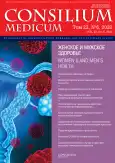Efficiency of uterine artery embolization in patients with placenta accreta
- Authors: Marchenko R.N.1,2, Kukarskaya I.I.1,2, Erbaktanova T.A.3
-
Affiliations:
- Tyumen State Medical University
- Perinatal Center
- Mother and Child Hospital
- Issue: Vol 22, No 6 (2020)
- Pages: 25-27
- Section: Articles
- URL: https://journals.rcsi.science/2075-1753/article/view/95271
- DOI: https://doi.org/10.26442/20751753.2020.6.200303
- ID: 95271
Cite item
Full Text
Abstract
Full Text
##article.viewOnOriginalSite##About the authors
Roman N. Marchenko
Tyumen State Medical University; Perinatal Center
Email: vrach08@rambler.ru
аспирант каф. акушерства, гинекологии и реаниматологии с курсом клинико-лабораторной диагностики
Irina I. Kukarskaya
Tyumen State Medical University; Perinatal Center
Tatyana A. Erbaktanova
Mother and Child Hospitalканд. мед. наук, глав. врач Клинического госпиталя
References
- Warrick CM, Rollins MD. Peripartum Anesthesia Considerations for Placenta Accreta. Clin Obstet Gynecol 2018; 61 (4): 808-27.
- Creanga AA, Bateman BT, Butwick AJ et al. Morbidity associated with cesarean delivery in the United States: is placenta accreta an increasingly important contributor? Am J Obstet Gynecol 2015; 213 (3): 384. e1-11.
- Maymon S, Maymon R, Bornstein J et al. Comparison of two approaches for placenta accreta: uterine preservation versus cesarean hysterectomy. Harefuah 2018; 157 (11): 696-700.
- Farasatinasab M, Moghaddas A, Dashti-Khadivaki S et al. Management of Abnormal Placenta Implantation with Methotrexate: A Review of Published Data. Gynecol Obstet Invest 2016; 81 (6): 481-96.
- Wang YL, Weng SS, Huang WC. First-trimester abortion complicated with placenta accreta: A systematic review. Taiwan J Obstet Gynecol 2019; 58 (1): 10-4.
- Carusi DA. The Placenta Accreta Spectrum: Epidemiology and Risk Factors. Clin Obstet Gynecol 2018; 61 (4): 733-42.
- Sun W, Yu L, Liu S et al. Comparison of maternal and neonatal outcomes for patients with placenta accreta spectrum between online-to-offline management model with standard care model. Eur J Obstet Gynecol Reprod Biol 2018; 222: 161-5.
- Reda A. Comments on: Conservative Surgical Treatment of a Case of Placenta Accreta. Rev Bras Ginecol Obstet 2018; 40 (10): 654-5.
- Long Y Chen Y, Fu XQ et al. Research on the expression of MRNA-518b in the pathogenesis of placenta accreta. Eur Rev Med Pharmacol Sci 2019; 23 (1): 23-8.
- Xu JQ. Effectiveness of embolization of the internal iliac or uterine arteries in the treatment of massive obstetrical and gynecological hemorrhages. Eur Rev Med Pharmacol Sci 2015; 19: 372-4.
- Курцер М.А., Бреслав И.Ю., Григорян А.М. и др. Актуальные вопросы лечения послеродовых кровотечений в акушерстве. Мед. алфавит. 2018; 1 (9): 14-7.
- Зверев Д.А. Методика временной эндоваскулярной эмболизации маточных артерий при оперативном родоразрешении. Евразийский союз ученых. 2014; 8-6: 24-5.
- Виницкий А.А., Шмаков Р.Г. Современные представления об этиопатогенезе врастания плаценты и перспективы его прогнозирования молекулярными методами диагностики. Акушерство и гинекология. 2017; 2: 5-10.
- Хасанов А.А. Диагностика, профилактика и органосохраняющие методы родоразрешения беременных с врастанием плаценты. Казанский мед. журн. 2016; 97 (4): 477-85.
- Олейникова О.Н. Оценка эффективности эмболизации маточных артерий при маточных кровотечениях различной этиологии. АГ-Инфо, 2009; 2: 38-42.
- Шадрин Р.В., Шумова М.А., Кулик В.В., Назарян Г.С. Органосохраняющие операции у беременных с врастанием плаценты: наш опыт. Науч. вестн. здравоохранения Кубани. 2017; 2 (50): 108-16.
- Дикун Т.В., Брагинец А.С., Терпелова А.С. и др. Эмболизация маточных артерий как метод лечения миомы матки. Молодой ученый. 2018; 16: 24-5.
Supplementary files






